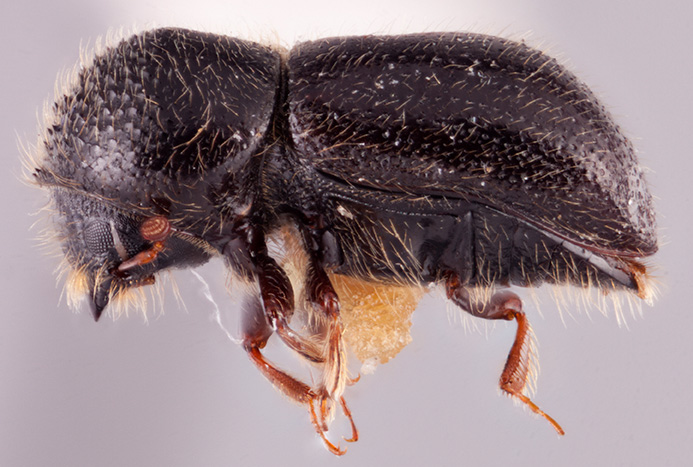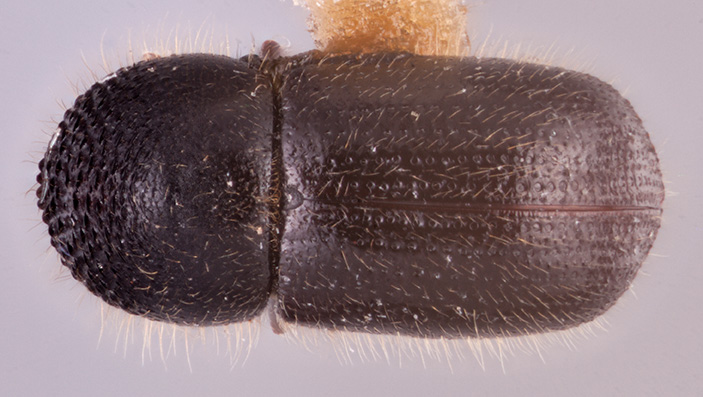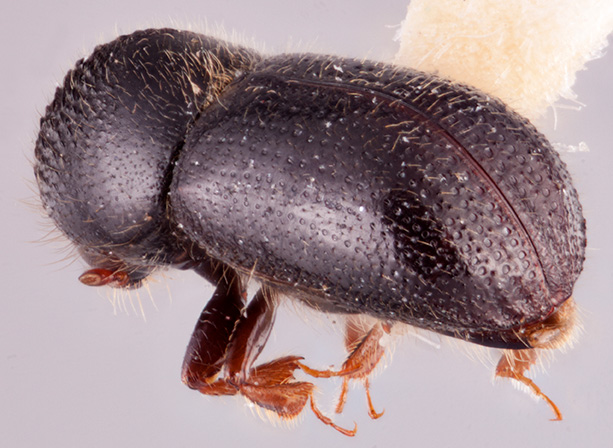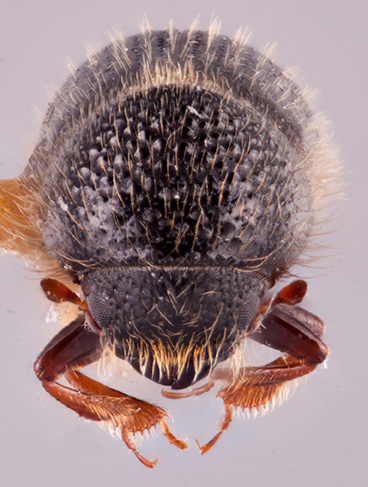Anisandrus dispar
|
Anisandrus dispar lateral; R.K. Osborn |
|
Anisandrus dispar dorsal; R.K. Osborn |
|
Anisandrus dispar declivity; R.K. Osborn |
|
Anisandrus dispar frontal; R.K. Osborn |
Taxonomic history
Apate dispar Fabricius, 1792: 363.
Anisandrus dispar (Fabricius): Ferrari, 1867: 24.
Xyleborus dispar (Fabricius): Hagedorn, 1910b: 98.
Anisandrus dispar (Fabricius): Hulcr et al., 2007: 578.
Synonyms
Bostrichus thoracicus Panzer, 1793: 34. Synonymy: Hagedorn 1910b: 102.
Scolytus pyri Peck, 1817: 207. Synonymy: Hubbard, 1897: 22; Swaine 1918: 124.
Bostrichus tachygraphus Sahlberg, 1836: 152. Synonymy: Eichhoff 1876b: 378.
Bostrichus ratzeburgi Kolenati, 1846: 39. Synonymy: Ferrari 1867: 27.
Xyleborus ishidai Niisima, 1909: 156. Synonymy: Smith et al. 2018b: 393.
Anisandrus aequalis Reitter, 1913: 81. Synonymy: Knížek 2011: 242.
Anisandrus swainei Drake, 1921: 203. Synonymy: Wood 1957: 403.
Xyleborus dispar rugulosus Eggers, 1922: 17. Synonymy: Schedl 1964d: 314.
Xyleborus cerasi Eggers, 1937: 335. Synonymy: Schedl 1964c: 220.
Xyleborus khinganensis Murayama, 1943: 100. Synonymy: Knížek 2011: 242.
Diagnosis
3.1−3.5 mm long (mean = 3.4 mm; n = 5); 2.27−2.5 times as long as wide. This species can be distinguished by the mesonotal mycangial tuftmycangial tuft:
tuft of setae that denotes the mycangia exterior opening
 disperse, mesonotal mycangial tuftmycangial tuft:
disperse, mesonotal mycangial tuftmycangial tuft:
tuft of setae that denotes the mycangia exterior opening
 the length of the scutellumscutellum:
the length of the scutellumscutellum:
a shield-like sclerotized plate located at the midpoint of the elytral base
; declivitaldeclivital:
pertaining to the elytral declivity
interstriae uniseriate granulategranulate:
pertaining to a coarse, grainy surface texture
 ; discaldiscal:
; discaldiscal:
pertaining to the disc of either the pronotum or elytra
interstriae with 2–3 confusedconfused:
of markings, having indefinite outlines or running together as lines or spots without definite pattern; usually referring to punctures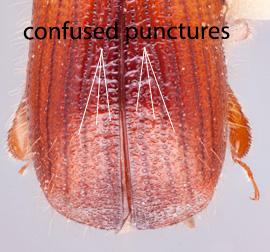 rows of punctures; declivitaldeclivital:
rows of punctures; declivitaldeclivital:
pertaining to the elytral declivity
interstriae 1 slightly raised, interstriaeinterstria:
longitudinal spaces along the elytra between the striae, which is not as<br />
impressed and bear smaller punctures.
 2 and 3 even; declivitaldeclivital:
2 and 3 even; declivitaldeclivital:
pertaining to the elytral declivity
face smooth, shiningshining:
appearing glossy or bright in luster; referring to a surface that is polished and reflects light well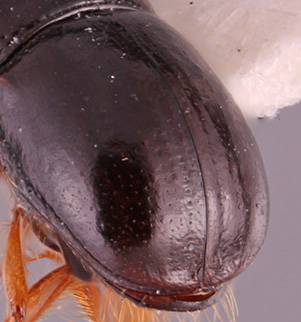 ; and interstrial setaeseta:
; and interstrial setaeseta:
small hair-like or scale-like structure
erecterect:
pertaining to setae that have their apices directed away from the body and appear straight
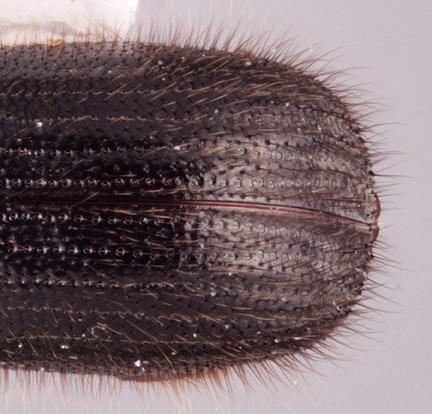 , 1.5 times the width of an interstriainterstria:
, 1.5 times the width of an interstriainterstria:
longitudinal spaces along the elytra between the striae, which is not as<br />
impressed and bear smaller punctures.
 .
.
May be confused with
Anisandrus maiche, A. paragogus, Xylosandrus dentipennis, X. eupatorii, and X. germanus
Distribution
Europe and North Africa, through Russia and Central Asia to China (Heilongjiang, Shaanxi), North Korea, and Japan. Introduced to Canada and USA (Wood 1977Wood 1977:
Wood SL. 1977. Introduced and exported American Scolytidae (Coleoptera). The Great Basin Naturalist 37: 67-74.; Gomez et al. 2018aGomez et al. 2018a:
Gomez DF, Rabaglia RJ, Fairbanks KEO, Hulcr J. 2018a. North American Xyleborini north of Mexico: a review and key to genera and species (Coleoptera, Curculionidae, Scolytinae). ZooKeys 768: 19-68. https://doi.org/10.3897/zookeys.768.24697).
Host plants
polyphagous, attacking both angiosperms and conifers (Wood and Bright 1992Wood and Bright 1992:
Wood SL, Bright DE. 1992. A catalog of Scolytidae and Platypodidae (Coleoptera), Part 2: Taxonomic index. The Great Basin Naturalist Memoirs 13: 1-1533., Beaver et al. 2014Beaver et al. 2014:
Beaver RA, Sittichaya W, Liu L-Y. 2014. A synopsis of the scolytine ambrosia beetles of Thailand (Coleoptera: Curculionidae: Scolytinae). Zootaxa 3875: 1-82. http://dx.doi.org/10.11646/zootaxa.3875.1.1)
Remarks
The biology of the species is described by Palm (1959), Chararas (1962), Egger (1973), and French and Roeper (1975). Speranza et al. (2009) examine the effects of temperature and rainfall on flight activity. Like many xyleborines, the species is attracted to ethanol (Saruhan and Akyol 2012Saruhan and Akyol 2012:
Saruhan H, Akyol I. 2012. Monitoring population density and fluctuations of Anisandrus dispar and Xyleborinus saxesenii (Coleoptera: Scolytinae, Curculionidae) in hazelnut orchards. African Journal of Biotechnology 11: 4202-4207. http://dx.doi.org/10.5897/AJB11.4185, Galko et al. 2014Galko et al. 2014:
Galko J, Nikolov C, Kimoto T, Kunca A, Gubka A, Vakula J, Zuacute;brik M, Ostriboň M. 2014. Attraction of ambrosia beetles to ethanol baited traps in a Slovakian oak forest. Biologia. 69: 1376-1383. https://doi.org/10.2478/s11756-014-0443-z). It is an important pest of hazel (Corylus avellana) (Betulaceae) in the Mediterranean area (e.g. Bucini et al. 2005, Saruhan and Akyol 2012Saruhan and Akyol 2012:
Saruhan H, Akyol I. 2012. Monitoring population density and fluctuations of Anisandrus dispar and Xyleborinus saxesenii (Coleoptera: Scolytinae, Curculionidae) in hazelnut orchards. African Journal of Biotechnology 11: 4202-4207. http://dx.doi.org/10.5897/AJB11.4185) and an occasional pest of fruit trees in the USA (Wood 1982Wood 1982:
Wood SL. 1982. The bark and ambrosia beetles of North and Central America (Coleoptera: Scolytidae), a taxonomic monograph. Great Basin Naturalist Memoirs 8: 1-1359.).
DNA data
Sequences available for COI and CAD.
COI: GU808699.1
CAD: GU808622.1

